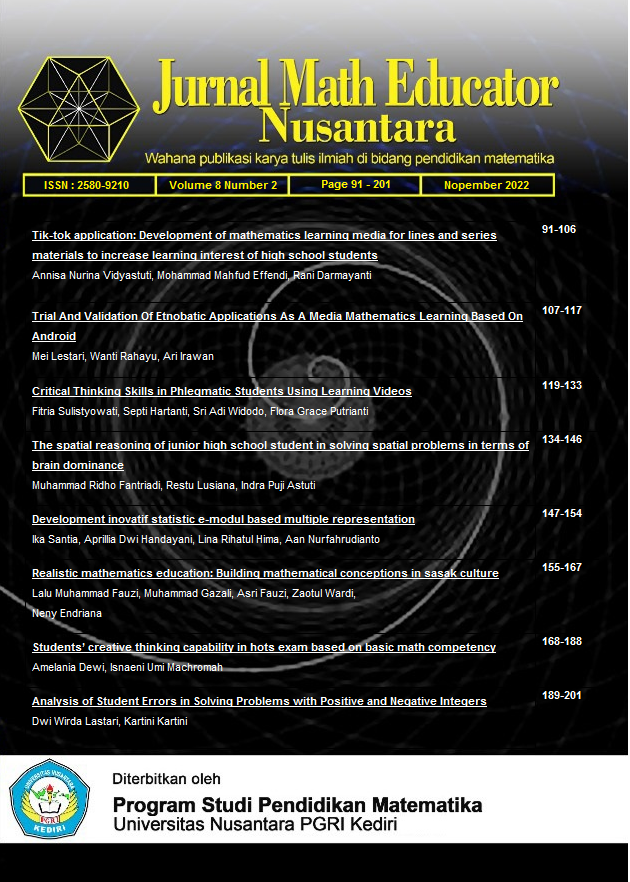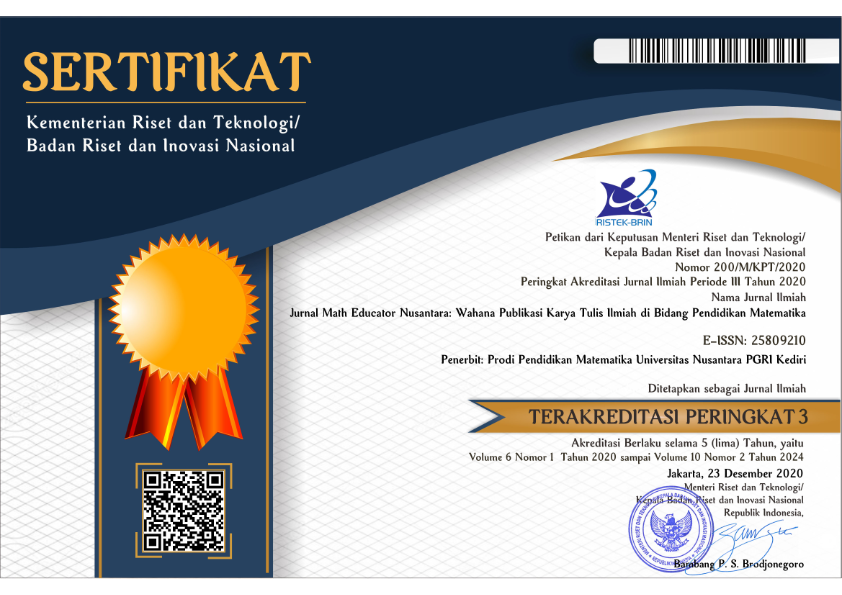Realistic mathematics education: Building mathematical conceptions in sasak culture
DOI:
https://doi.org/10.29407/jmen.v8i2.18885Keywords:
Realistic Mathematics Education, Mathematical Conceptions, CultureAbstract
In the context of cultural anthropology, people have known various mathematical activities, such as counting, measuring, and weighting, which have different terms based on each culture. We understand that mathematics emerges from people activities in responding to the existence of their environment. Sasak people conduct various cultural activities in their daily life. One of which is in agriculture and in the form of traditional arts, therefore, this study aims to build mathematical conceptions by exploring the activities of Sasak culture that can be integrated into mathematics learning contextually. This study was an ethnographic research. Data were collected through various literature studies, field observations, and interviews with savvy informants regarding Sasak culture, traditional farming system, and Sasak traditional arts. Research results indicated that the culture of Sasak people relevant with principles and characteristics of Realistic Mathematics Education (RME) is a learning approach that can be integrated, both explicitly and implicitly
References
Anisah, Zulkardi, & Darmawijoyo. (2011). Pengembangan Soal Matematika Model Pisa Pada Konten Quantity Untuk Mengukur. Jurnal Pendidikan Matematika, 5(1), 1-15. https://media.neliti.com/media/publications/121613-ID-pengembangan-soal-matematika-model-pisa.pdf
Ari Damayanti, N. K., Suarsana, I. M., & Suryawan, I. P. P. (2017). Peningkatan Kemampuan Literasi Matematika Siswa Melalui Penerapan Collaborative Learning Model. Wahana Matematika Dan Sains: Jurnal Matematika, Sains, Dan Pembelajarannya, 11(1), 33–42.
Ascher, M., & D’Ambrosio, U. (2012). Ethnomathematics : a Dialogue. For the Learning of Mathematics, 14(2), 36–43.
Barta, J., Jetté, C., & Wiseman, D. (2003). Dancing numbers: Cultural, cognitive, and technical instructional perspectives on the development of native American mathematical and scientific pedagogy. Educational Technology Research and Development, 51(2), 87–97. https://doi.org/10.1007/bf02504530
Barton, B. (2017). Mathematics, Education, and Culture: A Contemporary Moral Imperative. 43, 579–582. https://doi.org/10.1007/978-3-319-62597-3
Bishop, A., Seah, W. T., & Chin, C. (2011). Values in Mathematics Teaching — The Hidden Persuaders? In Second international handbook of mathematics education (pp. 717–765). Springer. https://doi.org/https://doi.org/10.1007/978-94-010-0273-8_24
Bonotto, C. (2017). How to replace the word problems with activities of realistic mathematical modeling. In W. Blum, P. L. Galbraith, H. Henn & M. Niss (Eds.),. In Modeling and Applications in Mathematics Education: The 14th ICMI Study (pp. 185–192). Springer. https://doi.org/10.1007/978-0-387-29822-1
Chin, C., & Lin, F. (2001). Mathematics teacher’s pedagogical value clarification and its relationship to classroom teaching. Proceedings-National Science Council Republic of China Part D Mathematics Science and Technology Education, 11(3), 114–125.
Clements, D. H., & Sarama, J. (2013). Rethinking Early Mathematics: What Is Research-Based Curriculum for Young Children? 121–147. https://doi.org/10.1007/978-94-007-6440-8_7
D’Ambrusio, U., & Rosa, M. (2016). Ethnomathemtics and Its Pdagogical Action. 13th International Congress on Mathematical Education Hamburg, July, 24–31.
Emmer, M. (2015). Mathematics and Culture II (Vol. 3, Issue 2). Springer US. http://repositorio.unan.edu.ni/2986/1/5624.pdf
Fauzi, L. M., & Gazali, M. (2022). The characters of the traditional residence of Sasak tribe based on sikut awak: An ethnomathematics study. Jurnal Elemen, 8(1), 55–65. https://doi.org/10.29408/jel.v8i1.4143
Fauzi, L. M., Gazali, M., & Fauzi, A. (2021). Ethnomathematics: A mathematical exploration on the layout of tui gubuk and the architecture of Segenter Traditional House. Jurnal Math Educator Nusantara, 7(2), 135–148. http://ojs.unpkediri.ac.id/index.php/matematika/article/download/235/150
Fauzi, L. M., Hanum, F., Jailani, & Jatmiko. (2022). Ethnomathematics : Mathematical ideas and educational values on the architecture of Sasak traditional residence. International Journal of Evaluation and Research in Education (IJERE), 11(1), 250–259. https://doi.org/10.11591/ijere.v11i1.21775
Fauzi, L. M., Hayati, N., Gazali, M., & Fauzi, A. (2022). Ethnomathematics : Exploration of Mathematics and Cultural Values in the Performing Arts of the Sasak Tribe Perisean. Hypotenuse : Journal of Mathematical Society, 4(1), 24–37. https://doi.org/10.18326/hypotenusa.v4i1.7240
Gözüyeşil, E., & Dikici, A. (2014). The Effect of Brain Based Learning on Academic Achievement: A Meta-analytical Study. Educational Sciences: Theory & Practice, 14(5), 642–648. https://doi.org/10.12738/estp.2014.2.2103
Heriyadi, H., & Prahmana, R. C. I. (2020). Pengembangan Lembar Kegiatan Siswa Menggunakan Pendekatan Pendidikan Matematika Realistik. AKSIOMA: Jurnal Program Studi Pendidikan Matematika, 9(2), 395–412. https://doi.org/10.24127/ajpm.v9i2.2782
Jayanthi, R. (2019). Mathematics in Society Development - A Study. IRE Journals, 3(3), 59–64.
Kline, M. (1990). Mathematics in Western Culture. Penguin.
Kusaeri, A., & Pardi, M. H. H. (2019). Matematika dan Budaya Sasak: Kajian Etnomatematika di Lombok Timur. Jurnal Elemen, 5(2), 125. https://doi.org/10.29408/jel.v5i2.1044
Laurens, T., Batlolona, F. A., Batlolona, J. R., & Leasa, M. (2018). How does realistic mathematics education (RME) improve students’ mathematics cognitive achievement? Eurasia Journal of Mathematics, Science and Technology Education, 14(2), 569–578. https://doi.org/10.12973/ejmste/76959
Lisnani, Zulkardi, Putri, R. I. I., & Somakim. (2020). Etnomatematika: Pengenalan Bangun Datar Melalui Konteks Museum Negeri Sumatera Selatan Balaputera Dewa. Mosharafa: Jurnal Pendidikan Matematika, 9(3), 359–370. http://journal.institutpendidikan.ac.id/index.php/mosharafa
Morgan, C. (2018). MATHEMATICS AND HUMAN ACTIVITY : REPRESENTATION IN MATHEMATICAL WRITING. Research in Mathematics Education, 1, 37–41. https://doi.org/10.1080/14794800008520091
OECD. (2016). PISA 2015 Assesement and Analytical Framework: Science, Reading, Mathematic and Finacial Literacy. Paris: OECD Publishing.
Prahmana, R. C. I., Yunianto, W., Rosa, M., & Orey, D. C. (2021). Ethnomathematics : Pranatamangsa System and The Birth-Death Ceremonial In Yogyakarta. Journal on Mathematics Education, 12(1), 93–112.
Spradley, J. P. (2016). The Ethnographic Interview. In The SAGE Encyclopedia of Communication Research Methods. Reissued Long Grove, IL: Waveland Press, Inc. https://doi.org/10.4135/9781483381411.n168
Stenhouse, L. (1997). Culture and education. New York: Weybright & Talley.
Sumarmo, U. (2011). Pembelajaran Matematika Berbasis Pendidikan Karakter [Character Education-Based Mathematics Learning]. Prosiding Seminar Nasional Pendidikan Matematika STKIP Siliwangi Bandung, 1, 22–33.
Supiyati, S., Hanum, F., & Jailani. (2019). Ethnomathematics in sasaknese architecture. Journal on Mathematics Education, 10(1), 47–57. https://doi.org/10.22342/jme.10.1.5383.47-58
Sutarto, S., Hastuti, I. D., & Supiyati, S. (2021). Etnomatematika: Eksplorasi Transformasi Geometri Tenun Suku Sasak Sukarara. Jurnal Elemen, 7(2), 324–335. https://doi.org/10.29408/jel.v7i2.3251
Tapsir, R. A. N. P. (2017). The Mathematics Values in Classroom Inventory: Development and Initial Validation. Malaysian Online Journal of Educational Sciences, 5(2), 82–90.
Yadav, S. (2020). Role of Mathematics in The Development of Society. IJRAR, 6(4).
Downloads
Published
Issue
Section
License
Authors who publish with this journal agree to the following terms:
- Copyright on any article is retained by the author(s).
- The author grants the journal, the right of first publication with the work simultaneously licensed under a Creative Commons Attribution License that allows others to share the work with an acknowledgment of the work’s authorship and initial publication in this journal.
- Authors are able to enter into separate, additional contractual arrangements for the non-exclusive distribution of the journal’s published version of the work (e.g., post it to an institutional repository or publish it in a book), with an acknowledgment of its initial publication in this journal.
- Authors are permitted and encouraged to post their work online (e.g., in institutional repositories or on their website) prior to and during the submission process, as it can lead to productive exchanges, as well as earlier and greater citation of published work.
- The article and any associated published material is distributed under the Creative Commons Attribution-ShareAlike 4.0 International License














